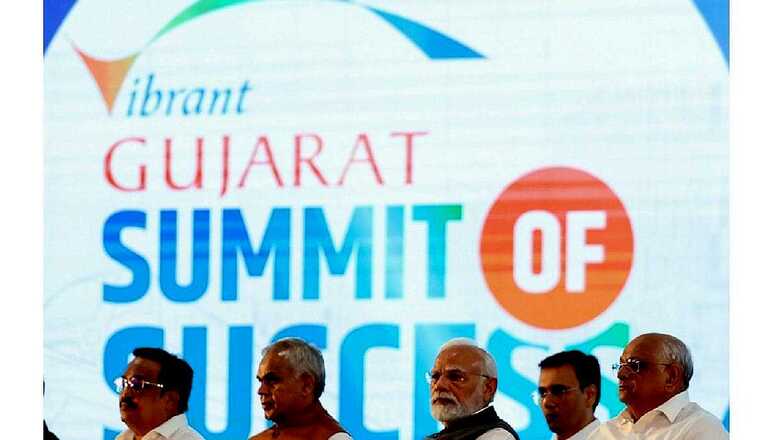
views
The Gujarat government’s industry-friendly policy, investments attracted through the platform provided by the Vibrant Gujarat Global Summit, and the upcoming PM MITRA Park in Navsari are set to boost the state’s efforts to promote the textile sector, officials and industry leaders said.
With over 60 per cent of the country’s denim fabric coming from Gujarat, the state is aptly considered as the textile state of India, they said, adding that the support provided by the state government through its textile policy for the last more than a decade has also contributed significantly to the growth of the sector.
Experts say that Gujarat’s textile policy has led to technological upgrades, skill enhancement and the development of textile parks, making it one of the most vibrant sectors. They believe that Gujarat’s textile industry will position itself as a driving force in the state’s economic growth and contribute to India’s prominence in the global textile market.
According to the state government, the development of PM MITRA Park in Navsari in south Gujarat is poised to attract over Rs 10,000 crore in investments, generating an annual output of Rs 25,000-Rs 30,000 crore.
It is expected to elevate the contribution of Gujarat’s apparel sector from 3 per cent to 5 per cent, overall textile output from 18 per cent to 22 per cent, and sector exports from around 12 per cent to over 15 per cent, it said.
As a precursor to the Vibrant Gujarat Global Summit (VGGS) 2024, the Gujarat government has so far signed 10 MoUs with textile and apparel manufacturing companies with a combined value of Rs 2,844.93 crore.
The MoUs pertain to the manufacturing of knitted products, viscose and polyester staple yarn, polyester films, and manufacturing of composite textile unit and denim dyeing and processing unit, a government release said.
The state government is progressing well to achieve Prime Minister Narendra Modi’s call to make India’s textile sector a “world champion” and using every opportunity to give a boost to the sector which has emerged as second only to agriculture in employment generation, it said.
“To make a profit in the future, we will have to invest in the local supply chain. This is the way to build a developed India and this is the way to fulfil the dream of a developed India, to fulfil the dream of a 5 trillion economy,” Modi had said in one of his speeches.
Over the last two decades, the VGGS has been instrumental in providing a platform for notable investments in Gujarat’s textile sector. It brings together both domestic and international industry leaders, creating partnerships for projects in the textile industry in Gujarat, industry representatives said.
The textile policy launched by the government in 2012 has attracted over Rs 35,000 crore in investment. Supported by pro-industry policy and meetings organised as part of the Vibrant Gujarat Global Summits, the sector witnessed a 2.3 times growth in exports by 2019, said Gaurang Bhagat, a textile business owner.
“Because of the meetings organised as part of the Vibrant Gujarat (Summit), the textile sector has seen a lot of improvements. Suggestions were received and beautiful progress made,” he said.
As a result of such a pro-industry approach, production of cotton spindles in Gujarat increased from 10 lakh spindles in 2012 to 46.3 lakh spindles in 2022-23, he said.
Gujarat’s textile policy has led to technological upgrades, skill enhancement and the development of textile parks, with a significant focus on rural employment and women’s empowerment, making it one of the most vibrant sectors, industry experts said.
In a seminar organised last month in Surat on the theme of ‘Future Ready 5F: Gujarat’s Textile Vision for Viksit Bharat@2047’ ahead of the 10th Vibrant Gujarat Global Summit, Minister of State for Textiles Darshana Jardosh announced a strategic focus on developing the technical textile sector with a commitment to the highest quality.
She said that the construction of PM Mitra Park in Navsari is anticipated to propel the textile sector to new heights in employment generation.
“The state government has proactively formulated policies addressing labour, industry and textiles, leading to significant advancements in the textile sector,” she said, while also underscoring the significance of ready-made garments using man-made fibres.
The government is actively promoting the development of the textile sector, she added.
During the seminar, Gujarat Minister of State for Industries Harsh Sanghavi said, “The textile sector has surpassed other industries in generating employment, and the state government is dedicated to making it a hub. Our government values diverse opinions and is committed to implementing effective policies.” According to Chintan Thaker, chairman of ASSOCHAM’s Gujarat Council, the state holds a significant position for textile industry entrepreneurs.
The textile sector provides the highest employment after agriculture in the state. In various other sectors, an investment of Rs 1 crore generates employment for 3 to 5 people, while in the textile sector, an investment of the same amount generates employment for 9 to 15 people, he said.
The state has encouraged the development of the textile sector through the Production-Linked Incentive (PLI), RoSCTL scheme (Scheme for Rebate of State and Central Taxes and Levies on Export of Garments and Made-ups), and policies related to Goods and Services Tax (GST) by the government, he said.
Projects such as PM Mitra Park and SagarMala are expected to elevate the contribution of Gujarat’s apparel sector from 3 per cent to 5 per cent, overall textile output from 18 per cent to 22 per cent, and sector exports from around 12 per cent to over 15 per cent, the experts said.
These proposed projects in and around Surat and Ahmedabad will begin with a projected timeframe by 2025 and are expected to create more than 11,400 employment opportunities, the release said.




















Comments
0 comment